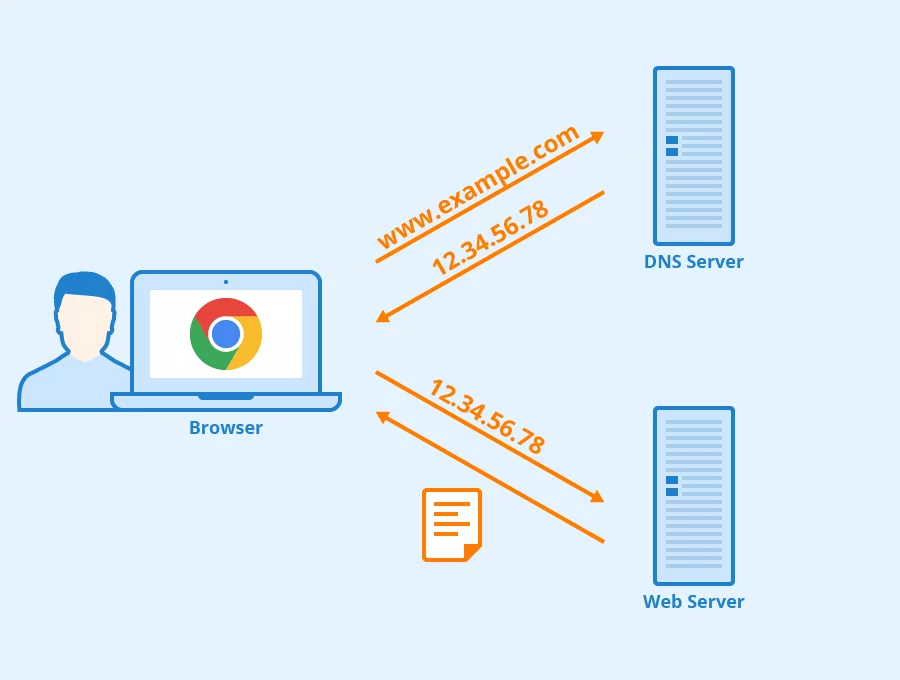Domain Name System, also known as the DNS in short, forms the most important part of the internet. It was invented around 40 years ago.
Anytime one types a domain name in the search bar, like google.com or ourdigitech.com, the browser connects to a DNS server to ask for the domain or the site’s IP address.
Simply put, every device connected to the internet has an IP address dedicated to it. That IP address is required for the computer to understand which computer or a device is situated in which location and how to reach there.
That information is provided by the Domain Name System, that is, DNS in short. Today, the DNS forms the most important part of the internet. It’s like an address book of the internet. Without this address book, one wouldn’t be able to access the internet.
The even easier way to understand is – take a house. Your computer don’t know how to reach that house. You just know its name – not its location. It’s the DNS server which tells your computer which house is situated in which country, state, city, location and street.
This alone, makes DNS among the biggest pillar of the internet. But DNS didn’t exist when the internet (its predecessor, to be precise) was invented. So how exactly was it invented. Let us know.
History Of The Internet
Decades ago, the internet as we know it wasn’t available worldwide. It was preceded by something called Advanced Research Projects Agency Network – ARPANET in short.
ARPANET was developed in the later parts of the 1960s by the Defense Advanced Research Projects Agency. It was used by the military and also by the universities for academic and research purposes.
As more and more computers joined the network, communicating through the computers with each other wasn’t easy.
To make it easy for computers to communicate with each other, The Stanford Research Institute used to manually maintain a file a text file named HOSTS.TXT. This name HOSTS.TXT might strike a bell to many who know a thing or two about it.
This HOSTS file back in the day used to contain numerical addresses and hostnames of all the computers in the network. This HOSTS file used to get distributed all over the network.
As more and more computers joined the network, maintaining this file was getting harder and harder. Additionally, by 1980s the accessing this file was getting slower and slower too.
If that wasn’t enough, getting a new computer added to the network wasn’t easy. One had to manually call the network operators to ask them to add the computer to the network, that too was possible only during work hours and working days. All had to be added manually by a limited number of humans operating the network.
Invention Of The DNS

An automated solution to this problem was becoming a need of the hour. This is when a certain computer scientist named Paul Mockapetris was asked to make improvements to the network.
Mockapetris was given five different proposals to improve the internet and find a middle ground between them. However, he designed something entirely of his own.
Paul Mockapetris designed a system where the naming duties were spread across a large number of servers located at the different parts of the network. While all the servers contained the same database, the responsibilities were divided between them. If one server went down, others were still accessible.
This system, was finalized in 1983. It was documented this month about 40 years ago, under RFC 882 and RFC 883 – both the files contain the original ideas in depth, authored by Paul Mockapetris.
However, the word DNS seems to have best implemented in the RFC 1034 and RFC 1035 memo authored four years later by Paul Mockapetris. It superseded the 1983 specifications.
By the 1980s, the internet was invented and DNS played an important role in the success of it. Without which, internet as we know it wouldn’t exist.
Modern Day Legacy Of The DNS
About a decade ago, Paul Mockapetris was added to The Internet Hall of Fame by Internet Society for the invention of the DNS. However, despite making such a significant and historic invention, many might not know his name. That’s why it’s also important to celebrate his contribution to the internet.
The modern day internet too seems to have changed when it comes to the DNS. Previously, many might not know much about DNS – their internet providers used to auto-set the DNS server of their liking and people used to access the internet using that, without knowing much about it.
Now, as internet access is getting more and more important, the role of the DNS is getting more important too. It’s not just about any DNS, the DNS of modern times needs to have quick response time and offer features and security.
There are many free and paid DNS server options available to the common users now. They can use Google Public DNS. They can also use Cloudflare’s 1.1.1.1 – something which we had covered in an article more than a year ago.
Then there’s also NextDNS, which provides a huge amount of features. But unlike Google and Cloudflare, it isn’t entirely free – it still allows 300,000 free queries per month, which is fine for casual users.
So yes. DNS was invented 40 years ago. Internet as we know it exists and runs due to it. It has evolved throughout the years. It remains and will continue to remain the most essential part of the internet.
- aum and phen0men4
-

 2
2



3175x175(CURRENT).thumb.jpg.b05acc060982b36f5891ba728e6d953c.jpg)
Recommended Comments
There are no comments to display.
Join the conversation
You can post now and register later. If you have an account, sign in now to post with your account.
Note: Your post will require moderator approval before it will be visible.